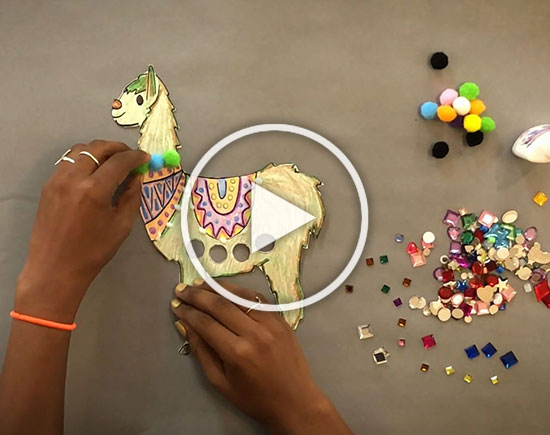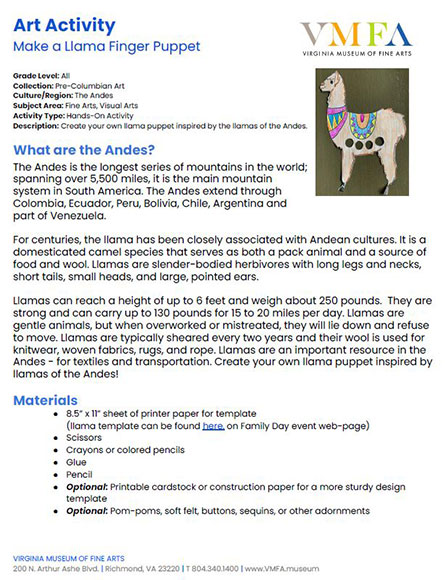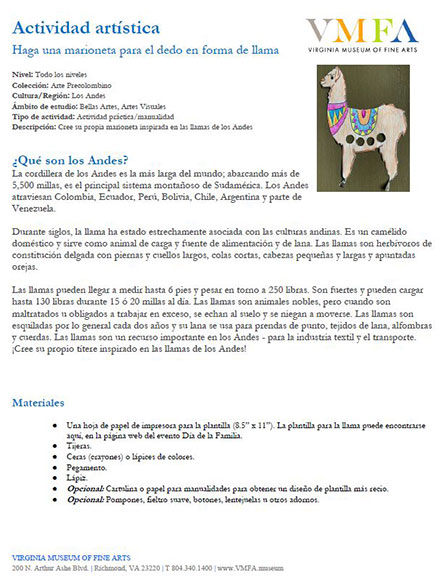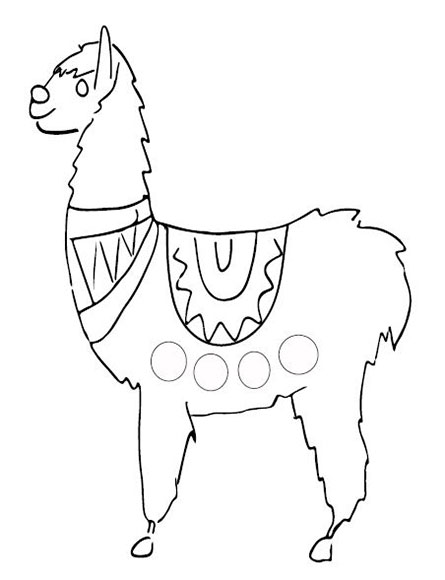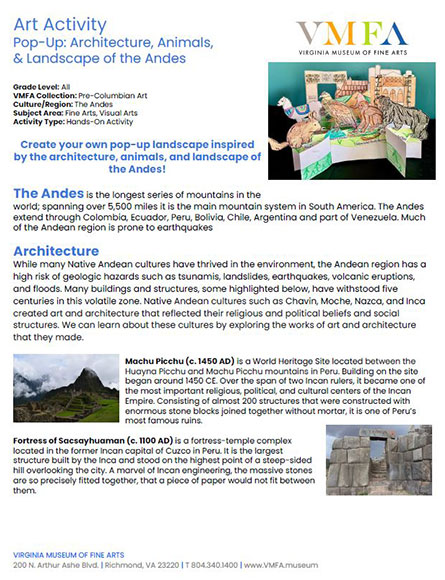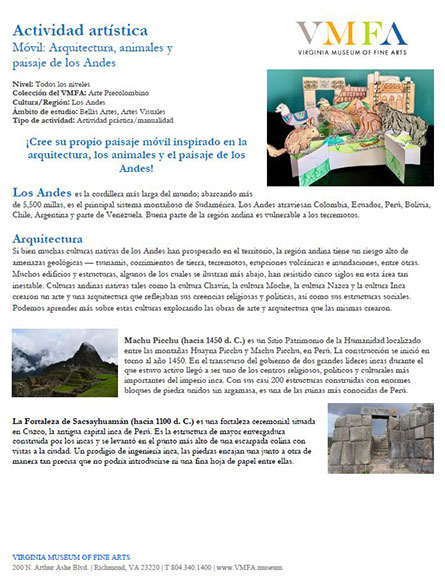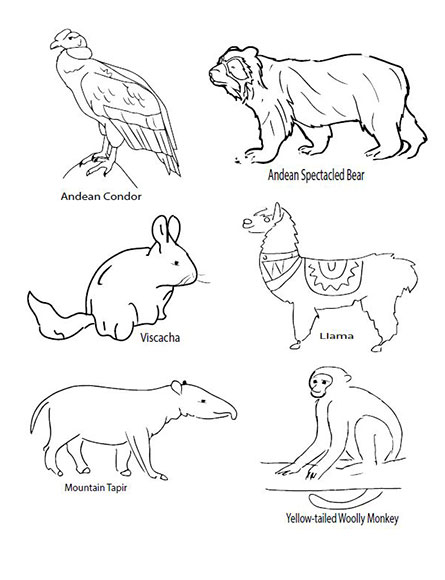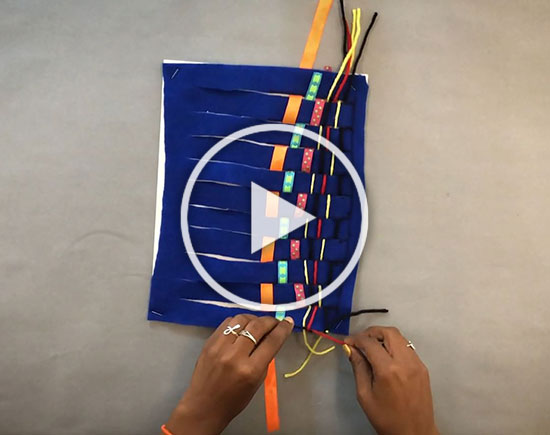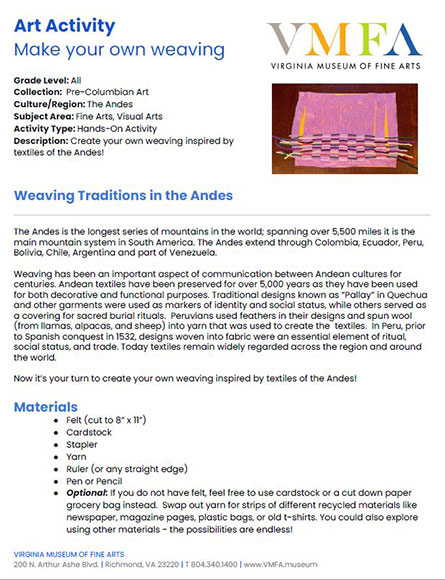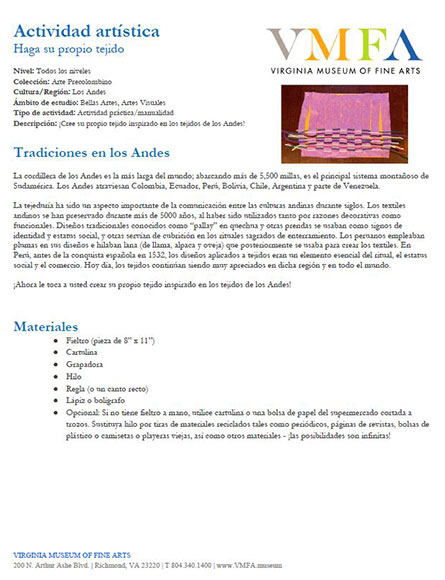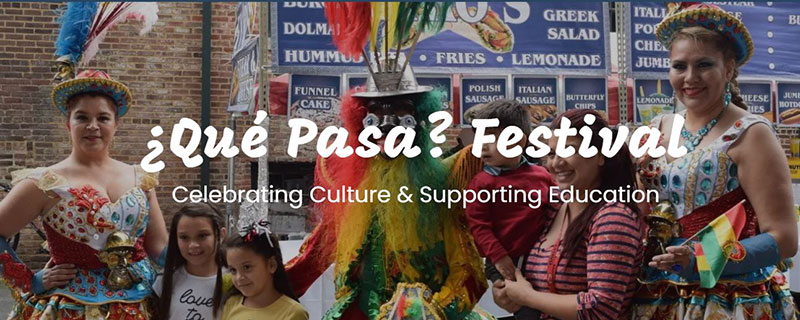Welcome to VMFA’s
VIRTUAL FAMILY DAY EVENT
Celebrate the Art of Latin America: The Andes
Thank you for joining us to celebrate the art and culture of Latin America at VMFA’s FIRST Virtual Family Day! Explore as we learn about the Andes through activities inspired by works of art in VMFA’s collection, performances by the Latin Ballet of Virginia, virtual gallery exploration, and more!
Generously Sponsored by
Exploring Our Virtual Event
Welcome to our first VIRTUAL Family Day! While we wish we could celebrate with you in person, we are celebrating with you virtually.
Now it’s time to explore. You will find an agenda outlining all the available activities, videos, and resources below. Take your time and explore them as you wish. The activities and presentations will be available to access through Sunday.
Maybe you would like to watch performances by the Latin Ballet of Virginia highlighting different Andean Legends? You can also explore other videos showcasing fantastic musicians, artists, and authors. Or, maybe you want to create your own work of art? Make sure you visit the museum’s galleries virtually and take part in fun activities!
All of these resources, and more, are listed below. Have fun, explore, and let your imagination roam!
Download the Agenda for the Event!
Available in both English and Spanish
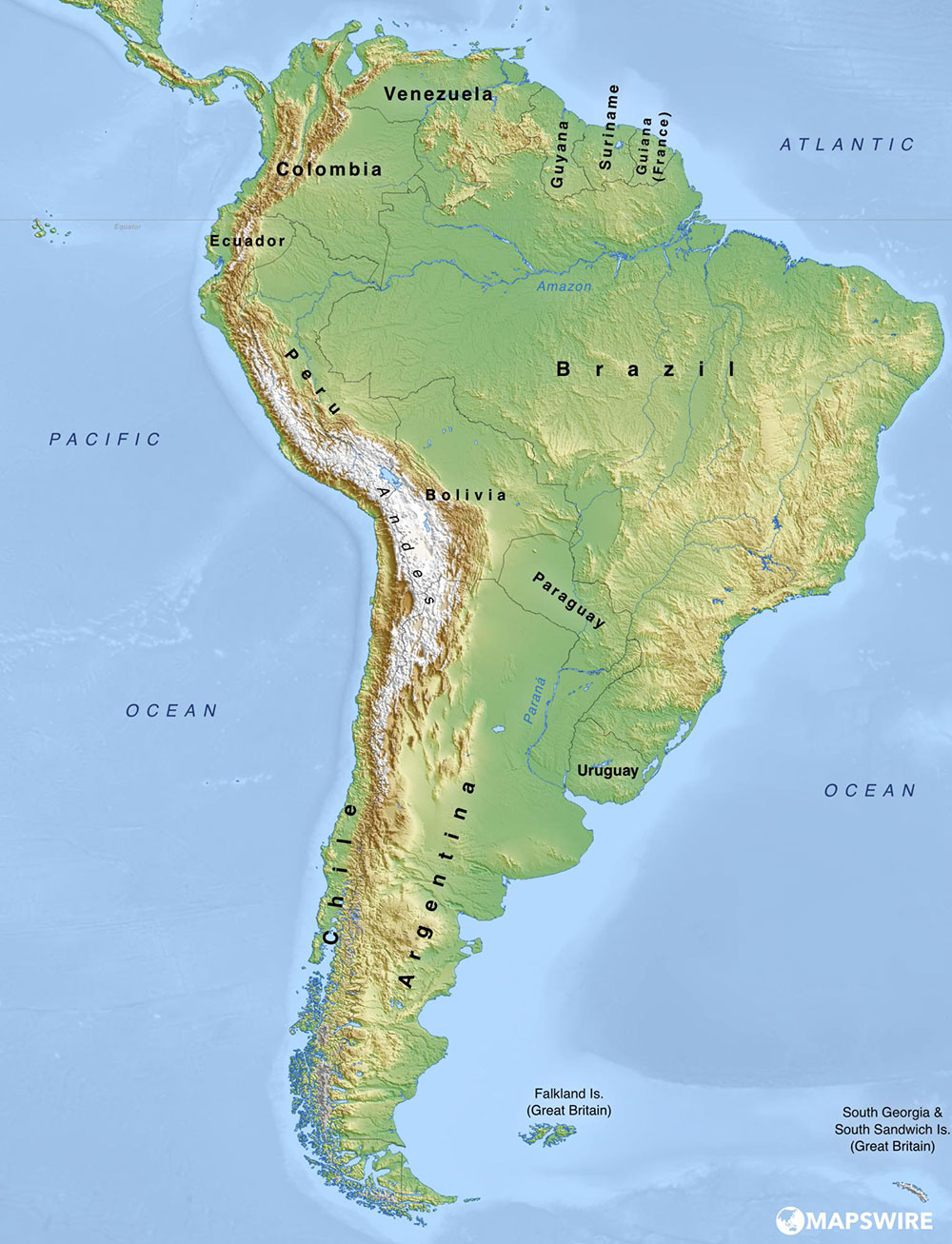
Performances, Presentations, and Demonstrations
Sit back and watch incredible performances and demonstrations! Follow the links provided below to view all presentations.
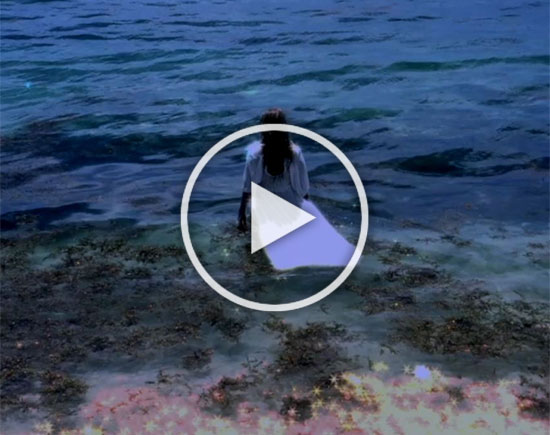 The Myth of the Pink River Dolphins
The Myth of the Pink River Dolphins
by the Latin Ballet of Virginia
Experience a performance by the Latin Ballet of Virginia as they use movement to explore the myth of the Pink Dolphins. The myth tells of pink dolphins born from the fresh waterfalls of the Andean Rainbow Mountain. Pink river dolphins are considered the guardians of the manatees and the Amazon and Orinoco Rivers.
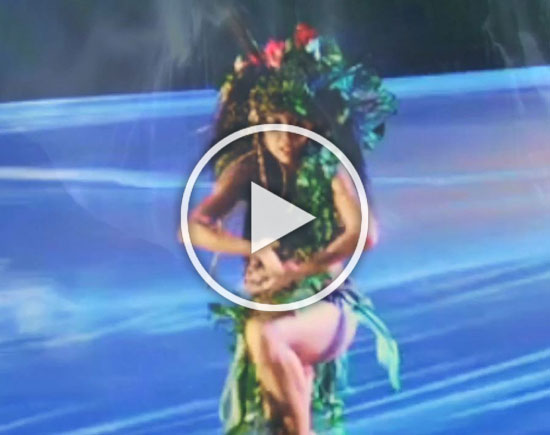 The Legend of Lake Titicaca
The Legend of Lake Titicaca
by the Latin Ballet of Virginia
Lake Titicaca is as old as it is mysterious. At three million years old, is the highest navigable lake in the world. It is the natural border between Peru and Bolivia and contains unmatched cultural, animal, and plant resources. Lake Titicaca is considered a sacred place, home of the Inca Empire. The Inca worshipped the god Tiki Viracocha, who created all things, ordering the sun (Inti), the moon (Mama Killa), the stars, and all forms of life to rise. The Incas believed that when they died, their spirits would return to Lake Titicaca, their place of origin. Many myths tell of sirens living in the depths of the lake.
Experience the Legend of Lake Titicaca, as performed by the Latin Ballet of Virginia.
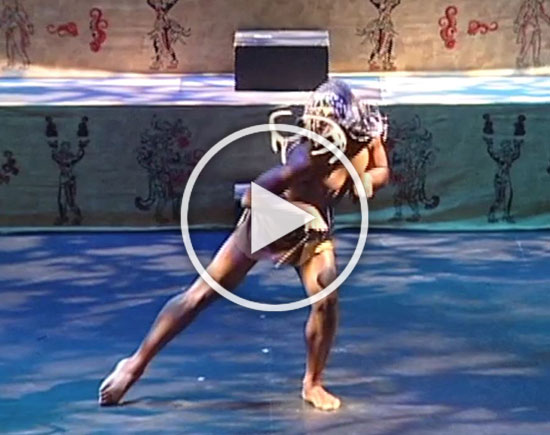 The Legend of El Dorado
The Legend of El Dorado
by the Latin Ballet of Virginia
Guatavita, the “Lake of Gold” in Colombia, holds the secret of El Dorado. Before the conquerors arrived in the country of the Muiscas Empire, they worshipped a princess who, on full moon nights, emerged from the bottom of the lagoon and strolled over the waters amid the thick mist. The legend claims that the heir of the chief (Cacique) covered his body with gold and sailed out on a golden raft to offer solid gold to the water in honor of the kingdom of the sacred lake and its precious princess. Now it’s your turn to watch the Latin Ballet of Virginia’s performance of this legend.
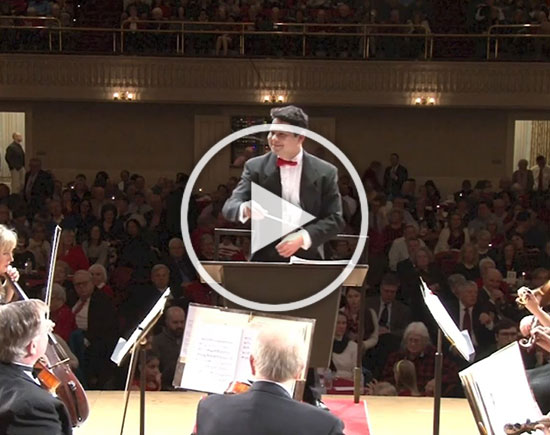 Inspired by Music with Jorge Soto
Inspired by Music with Jorge Soto
Born in Barquisimeto, Venezuela, Jorge Soto is the founding member of the Simón Bolívar National Symphony Orchestra of Venezuela, Music Director of the Sistema Side-by-Side Orchestra, and a product of El Sistema, a music program for social change. Join us as Soto talks about his musical background, passion, and role as a conductor in the Massachusetts Symphony Orchestra.
Learn more about Jorge Soto.
Learn more about El Sistema here.
Visit El Sistema USA website here.
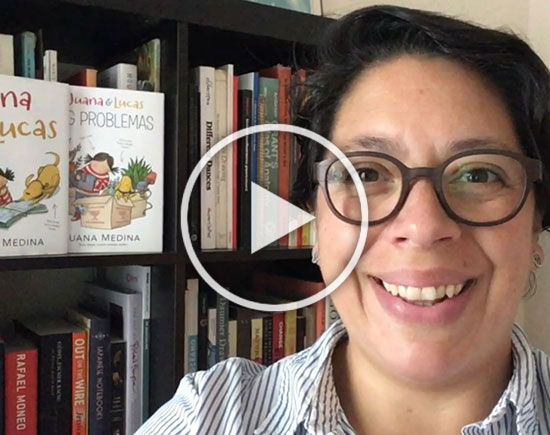 Author and Illustrator Juana Medina
Author and Illustrator Juana Medina
Meet children’s book author and illustrator Juana Medina, as she shares her love for Bogotá, Colombia. See how her drawings come to life as she describes her hometown. Born and raised in Bogotá, Colombia, Juana Medina is the author and illustrator of multiple children’s books, including the chapter book series Juana & Lucas, winner of the prestigious Pura Belpré Award and two International Latino Book Awards. The New York Times says of Juana & Lucas: “Medina’s beautiful, vivid prose conjures the Colombian setting with tactile language . . . the story itself is a giant hug.” Medina’s passion for storytelling has led her to work on exciting projects with numerous clients, among them the Library of Congress, ESPN, and PBS, as well as publishers such as Candlewick Press, Chronicle Books, Penguin Random House, Simon & Schuster, and Houghton Mifflin Harcourt. Learn more about Juana Medina.
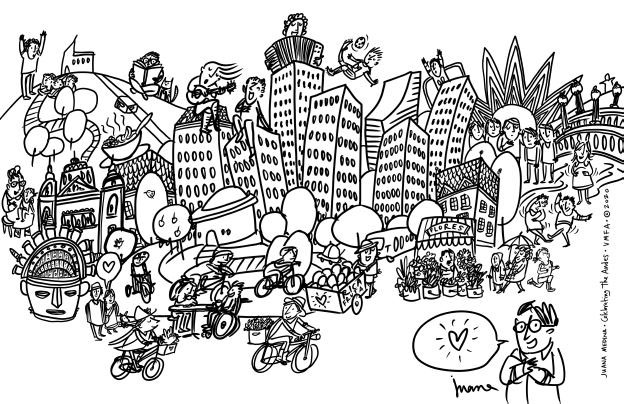
Download Juana Medina’s artwork
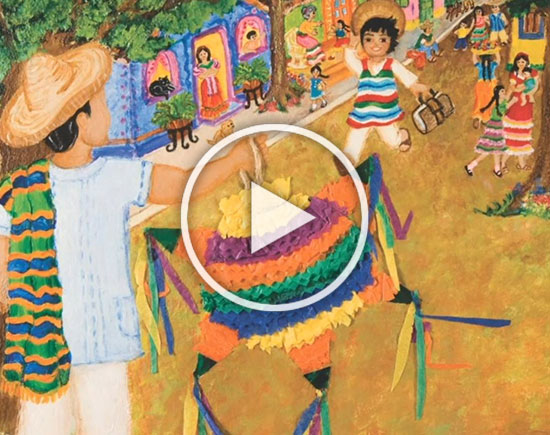 Storytelling with Lisa Zajur,
Storytelling with Lisa Zajur,
Author and Executive Director of Educational Programs at the Virginia Hispanic Chamber
Do you know what the piñata and the candy inside really represent, and why the piñata is broken? Find out when you join Lisa Zajur, author of Piñata Story, as she reads this bilingual book that transports readers on a cultural journey, highlighting a story about the meaning of the piñata while teaching Spanish. Get your copy at the VMFA Shop!
Learn more about National Hispanic Heritage Month, Sep 15–Oct 15, through the Virginia Hispanic Chamber’s Virtual Que Pasa Festival, where a portion of VMFA’s Family Day content and a selection of Spanish-language resources highlighting the museum’s collection will be available too. VMFA’s Virtual Family Day is FREE; registration is required.
Art Activities
It’s time to make art! Check out the art activities listed below. Under each art activity title and description, you will find a “how-to” video and an activity resource document containing all of the project and supplies information needed!
Follow the instructions included below to create your own paper llama puppet! Build a story around your puppet.
Download the Instructions and Template!
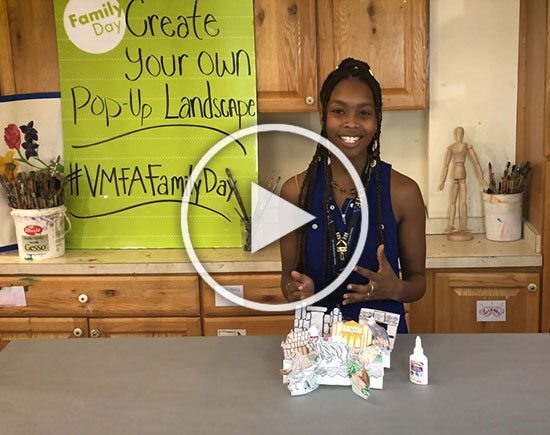 Pop-Up: Architecture, Animals, & Landscape of the Andes
Pop-Up: Architecture, Animals, & Landscape of the Andes
Make your own paper pop-up landscape and learn about the architecture, landscape, and animals of the Andes. Overlap different architectural and animal templates to create your own setting. Follow the instructions provided below to begin your project.
Download the Instructions and Template!
Use yarn, or different recycled materials to make your own woven masterpiece. Follow the instructions provided below to begin your project.
Download the Instructions and Template!
Virtual Gallery Activities
Explore the galleries virtually! See works of art from the museum’s permanent collection, and then participate in activities listed below:
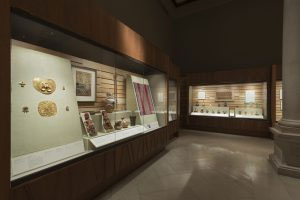 Gallery Preview:
Gallery Preview:
Explore the Pre-Columbian Galleries
Take a look in VMFA’s Pre-Columbian art collection and then try some closer looking activities. VMFA’s Pre-Columbian art collection includes over 200 ceramic vessels, textiles, sculptures, and metalwork objects from Meso, Central, and South America.
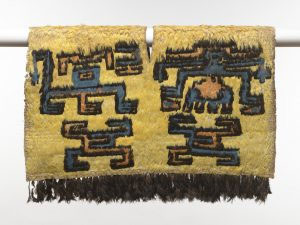 Interactive Exercise: Be the Artist
Interactive Exercise: Be the Artist
Works of art offer an opportunity to consider creativity in places and times that are different from our own. Spending time to look carefully at form, imagery, texture, and patterns of a work of art can encourage curiosity about the materials and techniques, artistic conventions, and cultural contexts of unfamiliar objects. Use this interactive exercise to further examine a work of art!
Ejercicio Interactivo: Sea el Artista
Interactive Exercise: Be the Artist
Tabard, AD 400-700, Unidentified Nazca Artist, South Coast, Peru. Andean, South America. Feathers on cotton. Dimensions: 46 x 30 ½ in. (116.84 x 77.47 cm). Pre-Columbian Art. 60.44.3.
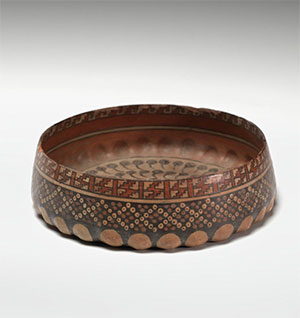 Looking for Pattern
Looking for Pattern
Cultures all over the world create decorative patterns, perhaps inspired by the enduring patterns of the natural world that surrounds us, from the cycle of the seasons to the arrangement of the stars in the heavens. Explore works from VMFA’s collection and create your own patterns! If you would like to sketch your own shapes and patterns, you will need a pencil and piece of paper.
Interactive Exercise: Be the Artist
Bowl, 1300-1450. Unidentified Inca Artist. South Coast, Peru, Andean, South America. Terracotta with polychrome slips. Dimensions: 2 ½ x 8 ¾ in. (6.35 x 22.225cm). Pre-Columbian Art. 59.28.15
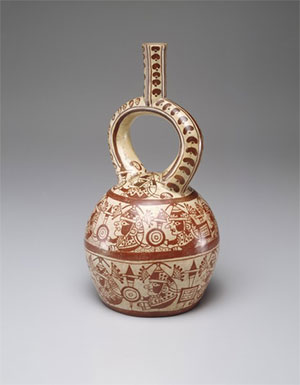 What is a Moche Stirrup Bottle?
What is a Moche Stirrup Bottle?
Discover the Moche culture and its ceramic traditions of stirrup bottles and fine-line painting!
Stirrup-Spouted Vessel, AD 200-500. Unidentified Moche Artist. North Coast, Peru, Andean, South America. Terracotta with brown slips. Dimensions: 11 ½ x 5 ⅝ in. (29.21 x 14.29 cm). Pre-Columbian Art. 82.193
Background Information: Rows of lima beans and images of “bean-warriors” appear on this Moche stirrup-spout vessel. These anthropomorphic combatants carry shields and clubs, and are adorned with helmets and ear spools. Lima beans were cultivated as early as 2000 BC in the Andes and were a common staple in ancient Peru.
Writing to Learn: Words in Their Mouths and Thoughts in Their Heads
Take a few minutes to look at the work of art seen below. Then, follow the Writing to Learn activity prompt below to engage with this work. You will need a piece of paper and a pencil for this activity.
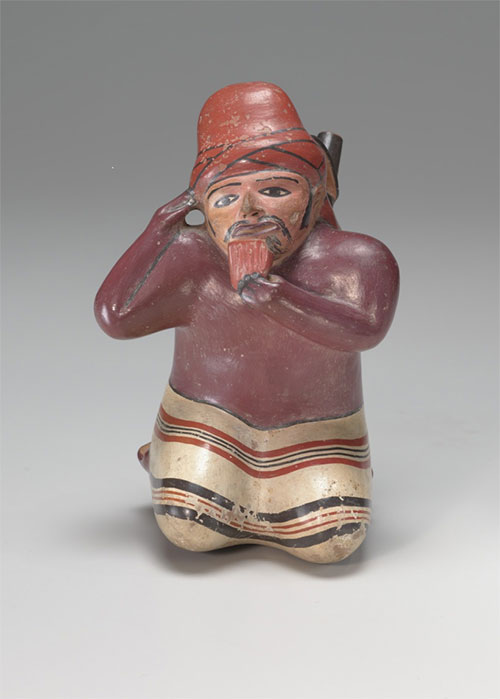
Musician Playing a Panpipe (Stirrup Spout vessel), AD 100-500. Unidentified Nazca Artist. South Coast, Peru, Andean, South America. Terracotta with polychrome slips. Pre-Columbian Art. 59.16.6
Background Information: This vessel depicts a seated musician playing a panpipe, or siku, an ancient Andean instrument. Ancient American rituals were closely associated with music and dance. For the Nazca the primary musical instruments were the panpipe and drum, but trumpets, flutes, whistles, and rattles were also used. Examples of a trumpet and whistle are also presented in this gallery.
Sensory Inventory
Take a few minutes to look at two works of art in the museum’s collection (see images below). Next, try incorporating all of your senses. Think about what you might see, feel, hear, taste, or smell.
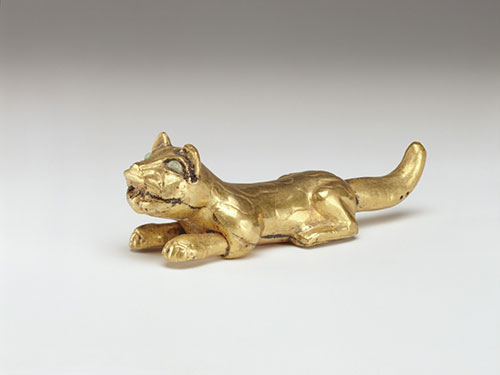
Jaguar, AD 100-800. Unidentified Moche Artist. Pampa Grande, Lambayeque Valley, Peru, Andean, South America. Gold, green stones (modern). Dimensions: 1 1/4 × 4 1/4 in.(3.175 × 10.795 cm). Pre-Columbian Art. 59.28.9.
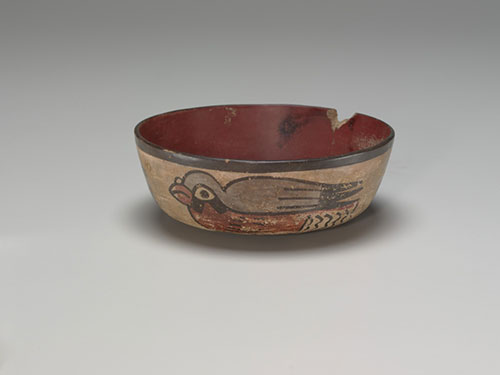
Bowl Decorated with Birds, 200-500 AD. Unidentified Nazca Artist. South Coast, Peru, Andean, South America. Terracotta with polychrome slip. Pre-Columbian Art. 74.1.5.
Now, use the format below to describe a work of art using your senses:
I can almost taste the _______________ and feel the _______________, it’s as if I hear the sound of _______________ and I am reminded of the smell of _______________. Strangely enough I think of _______________ when I see _______________.
Describir solamente la aparencia de una obra de arte es contar solamente una parte de su historia. Para otro tipo de descripción creativa, intente incorporar todos sus sentidos. Póngase a usted mismo dentro de la pintura. Piense en en lo que podría ver o sentir, y cuales sonidos, sabores o olores podría percibir.
Use el siguiente formato para describir una obra de arte :
Casi puedo percibir el sabor de _______________ y sentir el/la _______________. Es como si pueda oir el sonido de _______________, y me recuerda del olor de _______________. Es raro, pero pienso en _______________ cuando veo _______________.
Explore More: Community Connections & Other Resources
Accessing VMFA’s Library
The Margaret R. and Robert M. Freeman Library of the Virginia Museum of Fine Arts is the oldest and one of the most extensive art resources in Virginia, with visual arts reference material that addresses virtually all of the humanities. In addition to serving museum staff, it also acts as a non-circulating library for scholars, students, researchers, writers, and the general public.
To help limit the risks of COVID-19, the Margaret R. and Robert M. Freeman Library is currently closed to the public. The space is being redesigned to ensure public safety and to maintain physical distancing. The library plans to reopen in September, by appointment only. You can explore the library’s digital collections online. For reference assistance, please contact the library at library@vmfa.museum or 804.340.1495
Become a Member at VMFA
Looking for more family fun? Save $20 on a Family Membership using code: FAMDAY20
Offer available this month only. Expires 9/30/20.
Explore More on VMFA Learn
Watch artist videos and engage with more art from around the world!
Exploring e-Books
Interested in exploring and accessing free e-books through your local library? Check out apps such as Hoopla and The Libby App (OverDrive) that will connect you with e-books for a virtual reading experience. Please note, you need a library card to access e-books and other resources on these apps.
Learn More About the Libby App
Learn More About the Hoopla App
Virtual Que Pasa Festival
Learn about National Hispanic Heritage Month, Sep 15–Oct 15, through the Virginia Hispanic Chamber’s Virtual Que Pasa Festival, where a portion of VMFA’s Family Day content and a selection of Spanish-language resources highlighting the museum’s collection will be available too.
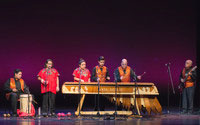
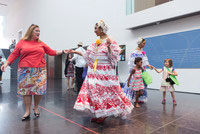
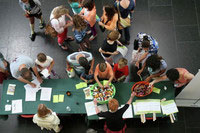
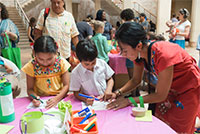
Thank you for joining us for our Virtual Family Day event! If you are interested in giving us feedback about this event, please click below.
Generously Sponsored by
Save the Date!
Celebrate African & African American Art: Egypt
Sun, Nov 8, 1-4 pm, 2020
ChinaFest: Year of the Metal Ox
Sat, Feb 6, 2021
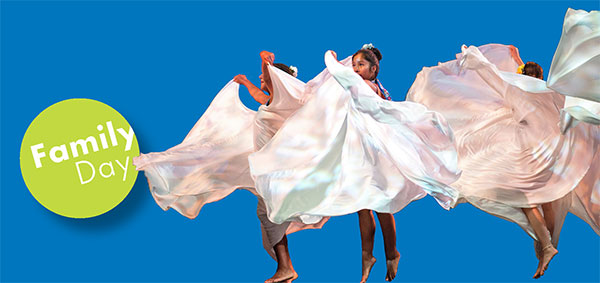



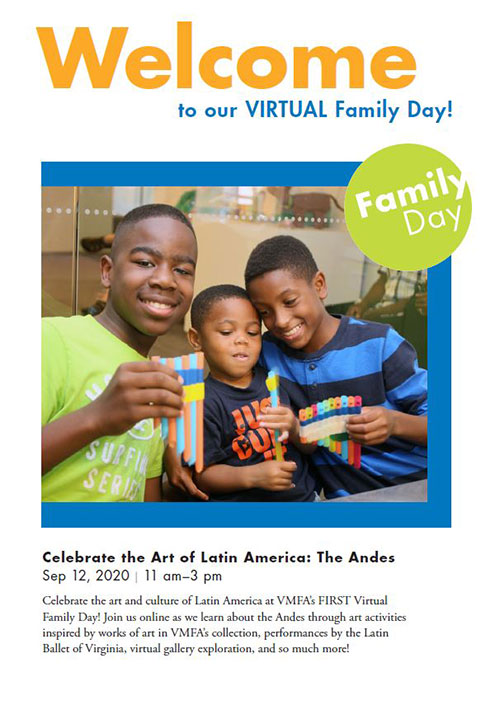 English
English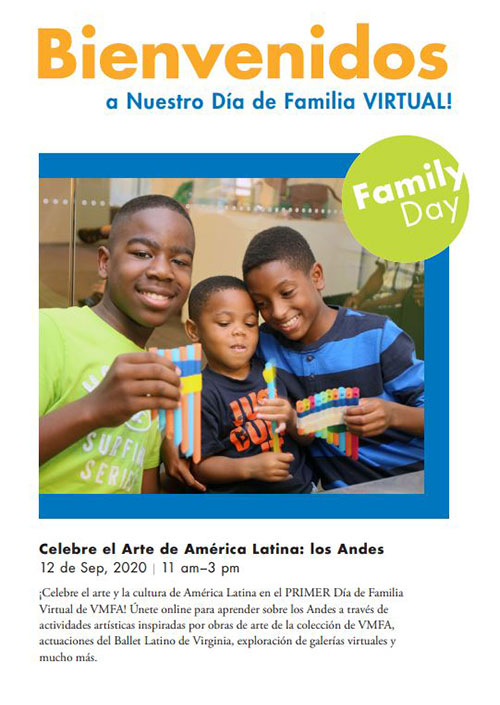 Español
Español